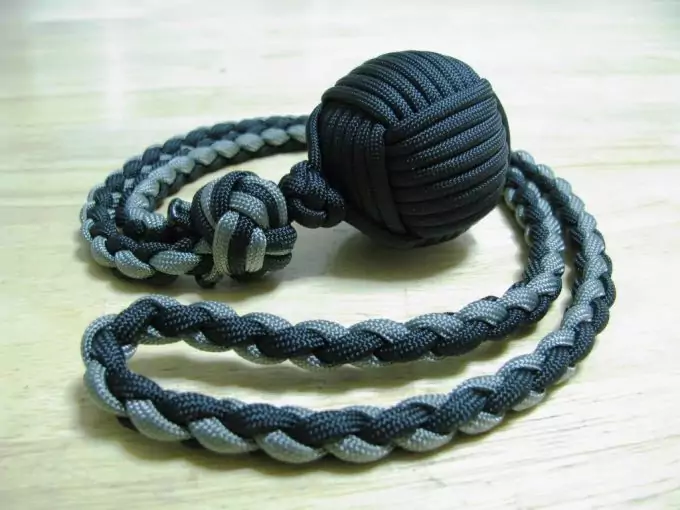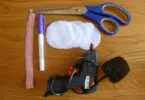The Paracord Monkey Fist is a knot with history behind it. The Monkey Fist is basically an adjustable noose made out of cords, often with a marble or steel ball in a knot at the end.
This post will cover the history of the Monkey Fist and explain how they are made. This is only an educational post. A Monkey Fist can be dangerous, and in some states, it is a prohibited weapon.
Table of contents
What is the History Behind the Paracord Monkey Fist?
Sailors first used the paracord Monkey Fist knot to pass lines between ships or between boats and shore. Instead of using marbles or steel bearings, they used other heavy objects like a bolt or a rock.

What are They Used for Now?
Now, people use the paracord Monkey Fist for many reasons.
- A convenient keychain – put your keys on the noose, and then inside your pocket or bag. Let the knot hang outside so you can grab the keys more easily.
- A zipper pull – if your favorite bag has a zipper that’s too small, you can conveniently place the noose through the zipper, and pull on the knot to open the bag faster.
- A toy for your pet – use the knot whenever you want to give your cat or your dog a toy to play with.
- Skydiving – replace the traditional handle for your parachute with a Monkey Fist, it’s stronger and more durable.
- Rock climbing – this is an archaic use of the Monkey Fist, but it still works. You can tie the Monkey Fist to the end of climbing rope. This makes it easier to throw the rope and the throws are more accurate.
Why Does it Work?
The monkey fist knot employs basic physics principles to obtain force and deliver a strong throw. Multiplying mass and acceleration, you’ll have to throw it pretty hard to get the force you desire.

So how do you do that?
- Use your muscle.
- Use distance to create more acceleration.
First, use your hip muscles to push the ball forward. This is a basic boxing technique, but it can also be used for throwing. Pivot on your front leg, and use the force to push your hand forward by swinging your hips
You’ll need to use centripetal force and twirl the ball in a semicircle with a radius of 30 inches from behind you to the front. This will provide 3 times more distance to work with.

Instead of having only 30 inches of cord to accelerate your ball, you’ll have almost 95 inches of distance, which is much better.
How Do You Make a Monkey Fist?
There are two ways to make a Monkey Fist, and I’ll show you how they both work. However, we won’t cover how to make the noose for the monkey fist.
To make your paracord Monkey Fist , you’ll need:
- A piece of cord
- Scissors
- A marble, steel ball or round rock.
- Glue
Remember…
- Be patient, it is unlikely to work on the first try.
- Make sure that the cord stays in place when tightening your fist.
- Start with a longer piece of rope or cord than the final length you have in mind for your flail.
- Always have a ball to place in the knot.
- A piece of round rock works just as well as a round steel ball for the .
The 3 Loop Monkey Fist
- Hold the rope properly. Hold your left hand open and put the rope over the edge so that the short tail is in front of your hand. The more significant portion of the rope will be behind it. You will be working with the bigger end, which you will be using to create the knot.
- Wrap the rope vertically. Grab the string by the extended portion and wrap it around your fingers in three steps. Start the first wrap where your fingers meet with your palm. The second and third wraps are a bit higher and closer to your fingertips. Use your index finger, middle finger, and ring finger to wrap the cord.
- Slide this looped cord off your hand. Be careful to keep the same orientation after taking the cord off your hand. Maintain your hand position so that the coils stay in place. Use your right hand to slide the cord off of your left hand, but keep the first set of turns in place.
- Keep the rope together with the use of your index finger and thumb. You have the option of keeping the rope on your left hand if you’d like. Then, thread the following horizontal coils between your fingers and palm.
- Wrap the rope horizontally. Take hold of the long tail and wrap it perpendicularly around the three vertical loops where your fingers used to be. Repeat this step 3 times. Each new horizontal strand has to be above the previous. You’ll end up with three loops of rope vertically. Three flat bonds now secure them.
- Remember not to tie the horizontal bonds too tight. They need to be a bit lose to create the perfect knot. After you make the flat turns, create another coil with what remains of your rope. To do this, place it through the three vertical threads. Next, make the final turn by passing your rope through the middle strand.
- Wrap the rope vertically again. At this point, you should be able to make another three steep turns. Grab the long tail and wrap it around the horizontal strands you’ve previously created. Place the rope through the opening, and pass through each flat wrap. Place your rope between the first three vertical loops.
- You should have enough rope to do this three times. After that, you’ll actually be weaving the rope around the existing strands. Be careful to introduce it through the top and pull it out of the bottom. At this point, the ‘s shape can be seen more clearly.
- Put the ball inside. Next, add something inside that will give it a bit of mass, like a marble, lead or steel ball, or even a round rock.
- Tighten the knot. This step will take you a bit longer. You need to be meticulous about how you tighten the . Pull each loop gently, starting with the first and last.
- Securing the slack means tightening each rope individually, but it’s important to follow the order in which you created the loops. Begin with the first set of vertical coils, followed by the horizontal curls, and then by the last vertical loops, you made in step 5.
Your paracord Monkey Fist is finished!
The Five Strand Monkey Fist
This is another excellent way to make a Monkey Fist if you’ve already mastered the first method.
- Hold the rope properly. First, ensure that the rope is positioned well. If you’re right-handed, open your left hand and put the rope in your palm, over the edges of your hand. As with the first method, the short tail will be in front of your hand, while the long, working tail will be behind your hand. Pull the short end as much as necessary in order to go past your little finger. Again, be careful to have a long enough piece of rope or cord, so that the short tail doesn’t come out of the knot.
- Wrap the rope vertically. This time, the cord should be coiled vertically 5 times. Grab it by the longer end, and then make 5 loops around your fingers. Each loop has to start near the place where your fingers meet the palm and end up closer to the fingertips. These wraps have to be one on top of each other. When you get to the final loop, you’ll wrap the cord around the finger before wrapping the cord again around your fist. After this, you will pull the cord towards you.
- Pull the rope off your hand. Next, maintain the same orientation the rope had on your fingers. Keep your left hand positioned similarly, in order to prevent the loops from falling apart. As with the first method, some people might find it more comfortable to keep the paracord on their fingers. If that’s the case, the horizontal loops you’re doing in the next step have to be placed between your fingers and palm.
- Wrap the rope horizontally. Tie the rope horizontally 5 times. For this purpose, you should grab hold of the long tail of the cord, and introduce it perpendicularly around the 5 vertical coils you just made. Repeat this movement 5 times. Each horizontal coil will be on top of the previous one. When you are finished, you’ll have 5 rope threads coiled vertically. They are also secured together by 5 horizontal straps. Remember, you don’t have to secure them firmly. After you’ve done that, wrap the last remaining loop around the first vertical strand.
- Wrap the rope vertically again. Now, you’ll have to work in the vertical plane again. Place the long tail of your cord inside the horizontal strands, from top to bottom. Repeat this motion 5 times. Wrap the cord between the first vertical loops, above and underneath the horizontal loops. Tie the last loop around the first vertical strand you created.
- Place the ball and tighten the knot. As in the first case, you need a weight inside the knot to strengthen it. Then, tighten the knot by gently pulling every loop you’ve created so far.
The Monkey Fist Noose
- Make the Monkey Fist knot. First, make this knot out of 3 or 5 strands, by following the steps we’ve previously described. Use a bigger piece of rope, long enough to be used as a noose. It’s also useful to have a key ring at hand, in case you want to use this noose as a keychain holder.
- Make the hangman’s noose. Create a symmetrical “S” shape with the remainder of the cord. After you have done this, wrap the previously created knot around this S shape of the rope. Do this 3 times consecutively, with movements similar to the ones used to create the Monkey Fist knot itself.
- Put the Monkey Fist inside the noose’s loop. Take the remaining strand and wrap it around 3 times, each time moving up closer to the hole. Use glue or super glue for the wraps and remember to cut off any excess paracord.
- Add your keychain to the cord. If you have a key ring available, weave it around the hole that emerges from the knot’s end. After that, attach your keys.

Final Thoughts on the Monkey Fist
A monkey fist (also known as a Slungshot) can be used for many purposes. However, it’s best to remember that, in some states, it’s considered illegal.
Carrying or attempting to use a Monkey Fist is a felony in several states.
- California
- Oklahoma
- Massachusetts
- Michigan
In other states, it is a gross misdemeanor.
- Nevada
- Washington
Make sure you research your state before attempting to carry or use a Monkey Fist.
This post provides instructions on making a Monkey Fist as only a general instructional article.









creating paracord things are making my kids busy lately, and this time they want to do monkey ball keychain, but i am not so sure what size of the steel ball to buy for? your thoughts?
1-inch chrome steel ball will work just fine.
Good knots can make or break numerous items around the household. I make it a priority to teach my kids how to tie different knots, and will definitely tell them all about the monkey Fist too. They will certainly have fun.
Thank you Ralph for sharing your opinion with us.